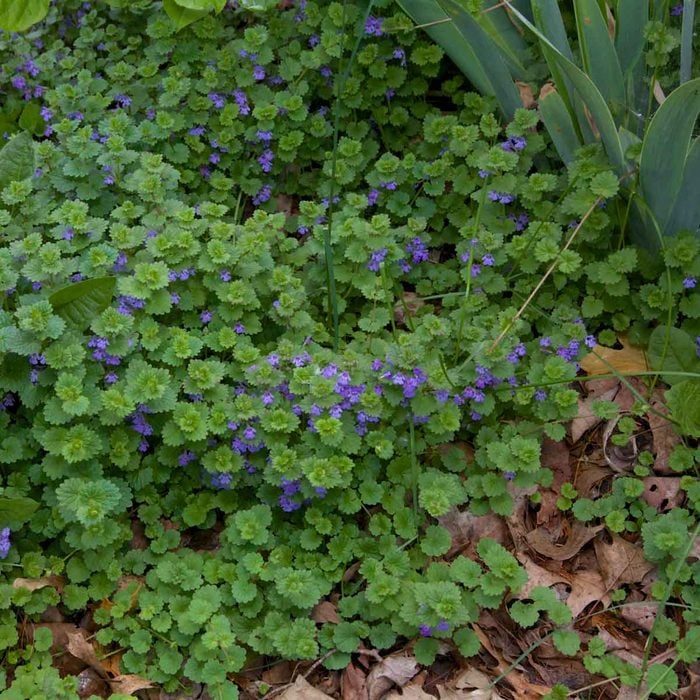How To Get Rid of Creeping Charlie

Brought to North America as an ornamental plant, creeping Charlie is now a rampant lawn weed that can quickly overrun your yard.
Our editors and experts handpick every product we feature. We may earn a commission from your purchases.
Part of the mint family, creeping Charlie was brought to the U.S. in the 1800s by European settlers who thought the resilient and adaptable plant would provide good ground cover for shaded areas. They were right, but this rapidly spreading invader soon became an aggressive nuisance plant to homeowners and gardeners across the country. To this day, it is considered one of the most difficult weeds to get rid of.
Known by botanists as Glechoma hederacea, creeping Charlie is also known as ground ivy, gill-over-the-ground and creeping Jenny. (Another plant, Lysimachia nummularia, is more commonly called creeping Jenny.) The name “creeping Charlie” most likely derives from its growth habit, according to Bob Mann, an agronomist and director of state and local government relations for the National Association of Landscape Professionals.
“The plant proliferates via its square-shaped stems that spread — or ‘creep’ — across the surface of the soil, rooting at the nodes,” he says. “Add in a little bit of creative alliteration, and you get ‘creeping Charlie.’ “
This step-by-step guide takes you through how to spot creeping Charlie and stop this invasive perennial in its tracks so your lawn can thrive.
On This Page
What Is Creeping Charlie?
Creeping Charlie is a broadleaf weed with a green vine, violet blossoms and round, fuzzy leaves with scalloped edges. It is most active in the fall, spreading rapidly to create a mat-like ground cover in weak or thin lawns with shady, moist areas. You can also spot it growing in full sun.
Creeping Charlie will emit a pleasant minty smell when cut with a lawnmower, Mann says, but this plant is no friend to your yard. “As it is an aggressively spreading weed that dominates in areas where turfgrass is at a disadvantage, it can take over large areas of lawns,” Mann says.
The vines that you see spreading across the surface of the ground also have tiny nodes throughout that form roots and rhizomes in the ground. Even if you dig out these persistent plants, their rhizomes may leave behind tiny fragments that can re-root and grow into new plants.
Is Creeping Charlie Safe?
Besides its origins as an ornamental plant, creeping Charlie once was popular for its medicinal benefits. it’s widely considered an edible plant fresh, cooked or dried. It has a tangy, mint-like flavor, but should be consumed with caution as some people can have an allergic reaction. If you decide to sample creeping Charlie, be sure to pick leaves that have not been exposed to fertilizers or herbicides and wash them well.
“There are many plants that cause what doctors refer to as contact dermatitis,” Mann says. “The substances within these plants that cause skin reactions are naturally occurring pesticides that the plants manufacture to discourage insects or animals from feeding upon them. But creeping Charlie does not cause contact dermatitis, nor am I aware of it being otherwise dangerous.”
How To Get Rid of Creeping Charlie
“Although hand-pulling is an option for creeping Charlie removal, it is usually not effective due to the rooted nodes throughout the vines,” says Drew Wagner of Sod Solutions. “The nodes have the opportunity to create a new plant over time.”
If you’d like to try your hand at eradicating the weed without chemicals, follow these steps:
-
Cut the leaves and creeping stems with gardening shears, leaving some length so you can pull up the roots by hand.
-
Discard the trimmings in a paper or plastic bag to avoid spreading plant fragments that can regenerate.
-
Soak the area you’ve cleared thoroughly with water. Wait at least 30 minutes before working the soil with a spade or trowel to loosen the remaining roots and rhizomes.
-
Pull out the roots, loosening the soil around particularly large or deep root systems with your spade or pitchfork to remove them in one piece. Place the plant and roots in a bag to discard without contaminating the surrounding area.
-
Carefully inspect the area and remove any remaining roots or rhizomes. You may need to go over the area multiple times to remove the entire root system.
Unfortunately, using herbicide to rid your lawn of this invasive weed is also tricky. “Creeping Charlie is among the most difficult weeds to control in lawns and landscapes as it is only vulnerable to herbicides at certain times of the year,” Mann says.
Follow these steps in the fall to treat your lawn with herbicide:
-
Don’t mow your lawn for two to three days before herbicide application.
-
Treat on a day when rain is not expected for at least 24 hours.
-
Spray the leaves and stems with a broadleaf post-emergent herbicide that contains triclopyr, dicamba, 2,4-D or MCPP. Allow the solution to soak down to the roots. Apply with care so you don’t spray any nearby foliage. “The most successful strategy is to apply it when the plant is actively growing during the spring or especially in the fall,” Mann says.
-
Do not irrigate for at least 24 hours after application.
-
Repeat the application. Then leave the treated area alone over the winter.
-
In the spring, collect any weed debris. Till and fertilize the soil with a nitrogen fertilizer.
-
Replant sod or reseed with turfgrass to cover any bare patches in your lawn, if needed.
How To Prevent Creeping Charlie From Coming Back
There are a few preventative measures you can take to discourage this pesky weed from creeping back onto your lawn:
-
Apply a pre-emergent herbicide in the spring to prevent reoccurrence.
-
Follow best management practices to encourage a vigorous lawn with regular mowing to a height of 2- to 3-1/2-in., fertilizing and watering, and overseeding in the fall.
-
Improve soil drainage or reduce irrigation to dry the soil and prune bushes or trees to decrease shade, creating a less favorable environment for creeping Charlie.
Most importantly, observe your lawn.
“Creeping Charlie is a weed that may indicate an area in your landscape that might not be the best for a lawn to grow,” Mann says. “If you find yourself simultaneously trying to control creeping Charlie and maintain a lawn, but failing at both because the area is too shaded, it might be an indication that another choice of plantings is in order.”



